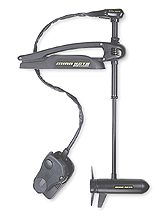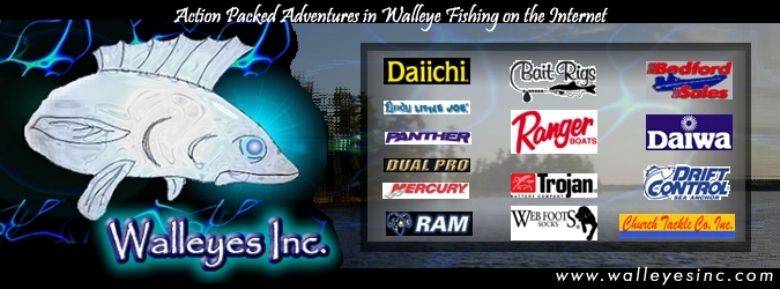|
Watching the weather patterns has allowed me to be very knowledgeable
about the habits and haunts of walleyes. If you watch the
weather you can put together a presentation that will allow
you to catch walleyes on any given day. Over the course of
years I have been able to put together some very interesting
facts and observations. For example, walleyes are not active
during low-light periods or during conditions they perceive
as low light. These days could be classified as overcast days
or windy days, because sunlight is diffused. Therefore, walleyes
tend to be higher in the water column and shallower on any
give structure. The low light periods which traditionally
have been the dusk and dawn periods of time. However, the
largest fish may feed in the dark of night. The darkness,
can give you the edge and become a great equalizer for adverse
weather conditions. Whether it's a cold front or a long bright
light day, you will catch more fish from dusk to dawn than
you do from dawn to dusk. If you experience only a few walleyes
being caught either during the day or at dusk and dawn, try
night fishing. This will especially hold true on clear water
lakes. Also, evidence suggest that many big walleyes are exclusively
night feeders, regardless of season or available light. If
you can catch walleyes in the midday hours without cloud cover
or wind, you are probably catching deep water fish or you
are on dirty, stained or murky waters and walleyes have a
tendency to bite all day long. During daylight, if you can't
fish during perfect conditions, it is usually better to concentrate
on deep fish, rather than shallow fish. You should look for
fish holding areas where wind crashes against a barrier or
where the wind churns up the water rather than fishing where
it is calm. Concentrate on dark water lakes that have a high
percentage of fish caught during the day. Sometimes in dark
mucky waters high bright sun filled days trigger a feeding
frenzy because the sunlight gets all the tiny critters moving
and in the cycle of fishing the end of the food chain will
be the bigger fish. A fish has two major components in its
environment. They are the water that the fish lives in and
the weather that is changing, not only seasonally but day
to day hour to hour and minute to minute. When either the
weather or water changes rapidly, a fish must have a period
of time to adjust to that change, and when it is adjusting
it is not in the mood to become active; its body doesnít allow
it. Thatís when some of the toughest fishing occurs. Specific
weather conditions tend to trigger a walleye feeding frenzy.
Basically it's a cold front, but there's more to it than that.
The ideal conditions for catching big walleyes may come only
a half-dozen times in a season. To make the most of them a
fisherman must watch forecasts and the clouds and be prepared
to fish one step ahead of the storm. The main concern dealing
with the movement of fish is a cold front. The frequency of
cold fronts vary in different parts of the country and at
different times of the year. Regardless of the weather patterns
in your part of the country, the cold front will have a profound
effect on your fishing results. A cold front is formed when
a mass of cold dry air collides with a mass of moist warm
air, pushing the warm air mass along, usually in an east to
southeast direction. Cold fronts are associated with rough,
unstable weather, such as a thunderstorm, squall lines, tornadoes,
rain or snow. The approaching cold front is not what bothers
the fish. In fact, some fast and furious action can be had
under ďpre-frontalĒ conditions. Itís what happens after the
front passes through the area. Usually, after a cold front
we are greeted with a drop in temperatures, a brisk wind from
a westerly to northerly direction, plus a bright, blue cloudless
day. The one element that harms the fish the most is light.
Thatís why the passing of a cold front is synonymous with
poor fishing. We get an intense light condition, a bright
blue sky, that will drive the fish to great depths. At these
depths the fish will become very dormant and inactive. A fish
has no eyelids to block out the light. Rather than fight a
bright light condition in shallow water, it will drop to a
lower level seeking a darker environment. This is not to say
you canít catch fish under bright conditions. Deep water interpretation
of structure and knowing where to fish deep, plus knowing
how to present lures at the proper depth and speed can help
offset these bad effects. Crankbaits are a great way to find
those walleyes in cold front conditions because you can cover
a lot of territory and concentrate on walleyes that are active.
You may catch more walleyes on live bait rigs, but youíll
catch a bigger average size on crankbaits. In addition, crankbaits
offer a rapid way to eliminate unproductive water. Plus, you
can use the crankbait as a locator bait and then finesse them
with live bait. Whenever you must fish in adverse conditions,
being either bright sunny days or changing weather conditions,
there should be a two step approach. One way is to slow down
your presentation.
|

Minnkota
101
|
Go slow, use the Minnkota trolling motor and make your
presentation very slow. Maybe even put on a single hook
with split shot rather than a walking sinker and vibrating
blades. Or the second approach is to go fast. Use fast
trolling speeds with artificial lures and speed troll
breaklines to get the fish active enough to bite. One
very important factor that I consider is weather stability.
Increasing weather stability will usually mean that there
will be more active fish, but keep in mind stable weather
doesn't mean four day of cold front conditions. Keep you
eyes turned toward the sky it will tell you if the weather
is about to change, and listen to forecasts on the radio
and T.V. they will give you an indication of what type
of day you will have. Remember the weather effects all
fish so if you are going to fish on any day think about
weather related walleyes before you slip that boat into
the water. I have more walleye weather techniques on the
web at, www.walleyeinfo.com.
Hope to hear from you soon!! |
|

